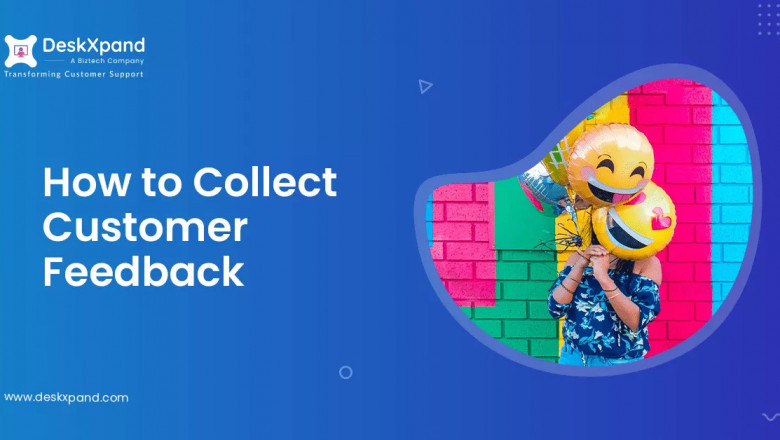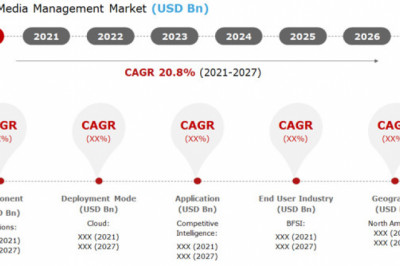views

Would love to get customers’ (honest) opinions but don’t know where to start and what to ask? Here’s the ultimate guide that will give you an idea of different ways to take customer feedback.
We will be discussing 4 commonly used customer feedback methods (that work!) with some best practices and tools to use.
An outline of topics this blog post covers:
-
A perspective on why your business; no matter its size, can’t do without customer feedback.
-
What are your reasons to collect customer feedback
-
Surveys, Surveys, Surveys
-
Use social media as a customer feedback tool
-
Collect Feedback Via Emails
-
Use contact forms, pop-ups, website widgets
-
Rules to collect better customer feedback & what to do next
Before we dive into understanding customer feedback methods, here’s something that you need to know, something that hardly gets discussed.
A perspective on why your business; no matter its size, can’t do without customer feedback
Most often than not, businesses believe that it’s their product that holds a satisfied, happy, loyal customer base.
They keep gathering customer feedback on how to improve their product, what more to offer, how to market, what does a user want, etc. etc.
However…
It’s not a product. But customer support that decides whether or not a customer wants to partner with you
Take this Quora story for instance. The user purchased a refrigerator from Lowe’s. The delivery got delayed by 8 days. To make things worse,
(a) the customer was not informed (b) support reps hung up the phone twice (c) the customer was put on hold for a very long time – perfect disaster recipe of poor support and dissatisfied customers.
Now Lowe’s is a popular name. Their products are solid. But what’s the point! One bad experience and customers will go elsewhere. Happily.
These days, customers are putting more and more emphasis on good service. No one likes to buy from companies that provide inferior service.
Hence, it is very important for your businesses to excel at customer service. Consider prioritizing your support department when you collect customer feedback.
Take surveys and reviews that help understand what are some loopholes. How is your support team performing? What are some areas of improvement?
Once you are able to track, measure, and analyze these things, you can deliver greater customer experiences that lead to a loyal customer base.
DeskXpand is one such robust help desk software that lets you create and share customer satisfaction surveys in just a few clicks. You can provide a rating scale, customize questions, and ask for customer feedback that helps you at each stage.
Track how well your agents and customer support departments are performing with customer satisfaction surveys. Take a demo today to learn more!
What are your reasons to collect customer feedback
Before you jump into the logistical part of gathering customer feedback, have a clear intention as to why you are asking for an opinion.
-
Do you want to improve an existing feature?
-
Do you want to see how satisfied your customers are?
What is it that you want to know? When you collect feedback, always ask the right questions. It will save both your and your customers’ time.
If you don’t use the information you’re asking for, you’re wasting your customer’s time. You’re also wasting yours. You’ll have a whole batch of responses to look through and none of them will make a difference. Instead, save time and get better responses, by including only the essential questions.
Kissmetrics’ Lars Lorgren
Secondly, when approaching customers for feedback, be super specific. Highlight aspects that you want their opinion on.
AND chuck the ‘feel free to drop us your views’ attitude. (Nope. I ain’t free! *eye roll*)
Come on! Feel free is something I tell my peers when I need views. You got a growing brand on your shoulders. You can do better! Spike conversations that are enticing, and would encourage customers to consider to move forward.
Look at Slack. The example is perfect because,
1. It’s a personalized message.
2. It is considerate (‘would you mind?’ indicates we-know-you-are-busy-but-your-opinion-really-matters).
3. The “60 seconds” and “we read every response” part is a great way to build trust.
If I got this in my mailbox, I would surely rate them!
Let’s move to the methods to collect customer feedback!
Surveys, Surveys, Surveys
Customer experience surveys are challenging but if you know how to do it right, you can yield best results. Below are four types of surveys you can conduct to collect customer feedback.
A. Customer Satisfaction Score (CSAT) Surveys
It is used to measure a customer’s contentment with a specific product, feature, transaction, etc. This type of survey has two parts: a question and an open-ended response.
CSAT matters since it gives you detailed insights into a specific interaction. Suppose, you have a SaaS product, throughout a product’s lifecycle – demo call, signup, onboarding, etc., you can leverage a CSAT survey.
You can send a link to fill out a CSAT survey in apps, email, pop-ups on websites, and such.
B. Net Promoter Score (NPS) surveys
This survey has a very specific use case – to know how likely a customer is to recommend your company to others.
You can use this type of survey to assess overall brand experience, product, service from qualitative and quantitative perspectives.
You can easily create one-page NPS surveys with the help of tools like Hubspot, HotJar, Survey Monkey, etc.
Ask your customers why they would recommend your organization. To make the experience even better, you can ask respondents to suggest what you can do to make things better in your company.
C. Visual rating survey
Instead of asking customers to give a written response, you can let them interact with a graphic. It could be stars, emojis, a slider scale, thumbs up/down, etc.
This type of survey is quick, intuitive, and visually appealing. You can share this type of survey immediately after a support conversation, at the bottom of a web page.
You can ask questions like:
-
Would you recommend this product?
-
How do you rate our customer service?
-
What options best describe your shopping experience on our website?
-
How would you rate your stay at our hotel?
Best practices to take surveys
One of the biggest challenges with surveys is to get honest and accurate feedback. Online publications reveal that predicting future intentions via surveys, for example, whether or not customers will buy from you again, is difficult.
Here’s what you can do:
-
Keep the length of the survey very short. Best if you can keep it under 5 mins. Remember, the longer the survey, the higher the dropout rate.
-
Ask questions with a clear purpose. A respondent must have clarity if the survey is for service, feature, ease of use, or bug fixing.
-
Close ended questions (yes/no types) should be a priority. However, using open-ended questions, you can also let customers share their thoughts.
Top tools to use
-
Google Forms: the most basic one, and absolutely free
-
DeskXpand: to create and send customer satisfaction surveys
-
Survey Monkey: use expert templates for creating surveys
-
Typeform: good for conversation type, engaging surveys
Pro tip: Use incentives to motivate respondents
Everyone likes good deals and free stuff. Increase the chances to get more responses by offering incentives. You can offer discounts, gift cards, coupons, free delivery, and such.
Create and share satisfaction surveys in just a few taps. Try DeskXpand today!
Use social media as a customer feedback tool
The way customers communicate is changing. They are more inclined towards using social media platforms to share their feedback.
So, put your existing social media accounts to good use by collecting feedback in various ways.
A. Listening is the first step
Do you know about Netflix’s DIY Socks?
That idea comes straight from listening to users on social media. The company came up with an idea of tech-enabled socks that can sense when you fall asleep and pause your show.
Thanks to social listening, Netflix became aware of the problem viewers face: falling asleep when binge-watching.
Social listening enables you to track hashtags, comments, mentions, posts, etc. that revolves around your business.
By monitoring mentions, you can know exactly what people are talking about your brand – both good and bad. It gives you real-time insights on issues people are having with your product or service.
B. Polls on Instagram and Twitter
Polls and questions on social media channels are not just about increasing engagement. They offer a brilliant opportunity to get the opinions of your customers. The best part? Conducting polls is free of cost!
(Use Instagram polls to know customers’ opinions)
If you are starting to develop a feature of a product, or considering launching somethings; polls can help in knowing customers’ opinions. Provided, you have an established fan following willing to respond.
Let’s be honest: the results you get from social media polls are not going to be totally reliable. But once a while asking lighter questions revolving your brand is not going to harm!
C. Live interactions and focus groups
Another way to collect customer feedback is by conducting Q/A sessions and live chat with your followers. It will not only boost engagement, but also help take real-time feedback.
Another effective way is to host focus groups. These are groups involving your target market where you share your ideas, ask questions, etc. Ask your existing and most loyal customers to be a part of such groups.
Best practices to use social media for feedback
Getting traction on social media platforms is not easy especially when you do not have an existing massive follower count. Here are a few things to consider.
-
You will get the best results when you choose the right platform where your audience is already active.
-
Try to include social media stories. The short-term urgent nature of stories is what makes them appealing and can help boost engagement.
-
You can consider using Facebook messenger chatbot. Using the auto-responder feature, you can ask followers or users who like/comment on your post to fill up a survey.












